Glossary of Print Techniques |
Glossaire des techniques de la Gravure |
|
|
INTAGLIO TECHNIQUE |
PROCÉDÉS EN CREUX |
| Grooves and other altered areas below the surface of a metal plate form or control the image. Copper and zinc are the usual materials for the plates. Ink introduced into the grooves and cleaned from the original surface of the plate will print when plate and dampened paper are run through a press under extreme pressure. Normally the plate is smaller than the paper and its impression, called the platemark, remains on the paper. When a limited edition of impressions has been printed, the plate is usually cancelled by being defaced with cross-hatching to ensure it cannot be reprinted. | Le graveur entaille directement une planche métallique - habituellement une plaque de cuivre ou de zinc. Au moment de l'impression, il répand de l'encre dans les parties creuses. Puis, la surface étant bien essuyée, il met la planche et une feuille de papier trempée sous une presse sur laquelle il exercera une forte pression. À noter que les dimensions de la planche sont normalement plus petite que celles du papier où l'image gravée reproduite. L'impression laisse autour de l'image une empreinte en creux appelée curette. Le graveur imprime un nombre limité d'épreuves, après quoi il raye la plaque pour empêcher toute réutilisation. |
| ENGRAVING |
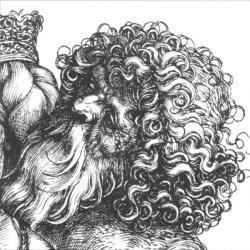
|
GRAVURE AU BURIN |
|---|---|---|
|
Albrecht Dürer, detail from Coat of Arms with a Skull, 1503 National Gallery of Canada. |
Albrecht Dürer, détail de Les armoiries à la tête de mort 1503 Musée des beaux-arts du Canada |
|
A sharply pointed instrument called a burin is pushed into the copper to execute the design. Acting like a plough moving into the earth, the burin forces copper shavings to either side of the furrowed lines. Usually these shavings, called burr, are scraped from the plate before printing. An engraved line can be distinguished by the fact that it tends to swell towards its middle and taper to a fine point at both ends. It has a sharp, clean appearance. |
Au moyen d'un instrument extrêmement pointu - le burin -, le graveur entaille le cuivre. Agissant comme une charrue qui remue le sol, le burin soulève des filaments - la barbe - de chaque côté du sillon. Cette barbe est normalement retirée avant l'impression. Les traits au burin, nets et fins, s'élargissent habituellement au centre, tandis que leurs extrémités sont effilées. |
| DRYPOINT |
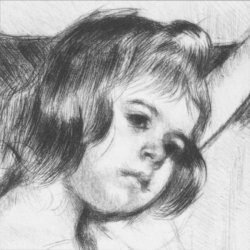
|
GRAVURE À LA POINTE SÈCHE |
|---|---|---|
|
Mary Cassatt, detail from Kneeling in an Armchair, 1904 National Gallery of Canada. |
Mary Cassatt, détail de Enfant au fauteuil, 1904 Musée des beaux-arts du Canada |
| The image is scratched out of the copper surface with a very finely pointed instrument which creates a heavily burred line. The line is more shallow than the engraved line but its burr is more distinct. The burr is not scraped away. It catches ink and, when printed, creates lines of velvety richness. Because the burr wears down quickly, only a very limited number of good impressions can be pulled. | Le trait est creusé dans le cuivre avec un instrument bien affûté qui soulève une barbe abondante. Il est moins profond que dans la taille au burin, mais sa barbe, qui sera conservée, est plus forte. Celle-ci a pour fonction de retenir l'encre et, lors de l'impression, elle confère au trait une sorte de velouté. La fragilité de la barbe limite cependant le tirage. |
| MEZZOTINT |
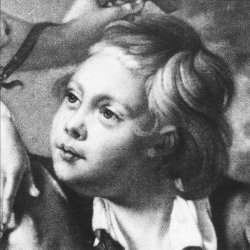
|
MANIÈRE NOIRE OU MEZZOTINTE |
|---|---|---|
|
Valentine Green (after Joseph Wright of Derby), detail from The Wright Family, 1769 National Gallery of Canada. |
Valentine Green (D'après Joseph Wright of Derby), détail de La famille Wright, 1769 Musée des beaux-arts du Canada |
|
The surface of a copper plate is roughened all over with a rocker, an instrument with a half-round cutting edge serrated with fine teeth. If a print were made from the plate at this stage, it would appear uniformly black. Using a scraper and burnisher to flatten and press the copper, the artist makes areas of the surface smooth again, so that they do not hold ink and therefore print white. The mezzotint process is based upon creating gradations of tones in the image from dark to light. |
Au moyen du berceau, instrument à lame courbe dont la partie utile est finement dentée, la planche de cuivre est recouverte d'un grain rugueux. Une épreuve tirée à cette étape-ci serait d'un noir uniforme. À l'aide du grattoir et du brunissoir, l'artiste aplanit les aspérités de certaines parties de la planche pour qu'elles ne retiennent plus l'encre. La manière noire repose ainsi sur la création de dégradés qui vont du noir profond au blanc pur en passant par des gris légers. |
| ETCHING |
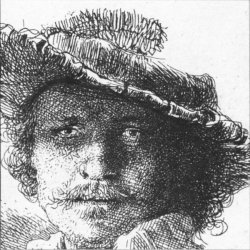
|
EAU-FORTE |
|---|---|---|
|
Rembrandt, detail from Self-portrait with Saskia, 1636 National Gallery of Canada. |
Rembrandt, détail de Autoportrait avec Saskia, 1636 Musée des beaux-arts du Canada |
| The plate is first covered with an acid-resistant resinous substance. The artist then takes a finely pointed needle and draws the design out of this resinous ground. The drawing instrument does not cut into the metal surface. The image which will print is represented by the areas in which the copper of the plate has been exposed. The plate is then immersed in an acid bath. The acid eats into the plate only in those areas not protected by the ground. The length of time the plate remains in the acid bath determines the depth of the etched lines. These lines tend to be even in width throughout their length. Unlike engraved lines, they do not taper but are rather square at the ends. Since the artist can draw freely in the resinous ground, the etched line has a more spontaneous quality than the engraved line, which is harder and more precise in appearance. | L'artiste recouvre d'abord la planche d'un vernis dur que les acides n'attaqueront pas. Le graveur prend ensuite une pointe d'acier fine et dessine son motif sur ce vernis, mais sans que sa pointe n'entame la surface du métal. L'image à imprimer correspond aux parties du cuivre ainsi mises à nu. La planche gravée est ensuite plongée dans un bain d'acide qui attaque les parties du métal qui ne sont pas protégées - c'est la morsure. Le temps plus ou moins long que la planche passe dans l'acide détermine la profondeur des traits. Ceux-ci ont tendance à être de même largeur sur toute leur longueur. À la différence de la gravure au burin, leurs extrémités ne sont pas effilées mais plutôt carrées. Le vernis laissant plus de liberté à l'artiste, le trait gravé à l'eau-forte est plus spontané que celui, plus dur et plus précis, qui est buriné. |
| S0FT-GROUND ETCHING | VERNIS MOU |
|---|---|
| The plate is covered with a mixture of ordinary etching ground and suet. Over this the artist stretches a piece of thin paper, then draws the composition on it with a pencil. Wherever the pencil touches the paper, it presses it down into the soft ground so that, in that place, the ground sticks to the paper. When the paper is peeled from the plate, it takes with it the ground which adhered to it. The plate is then bitten. | Sur une planche recouverte d'un vernis ordinaire additionné de suif, l'artiste pose une feuille de papier à grain fin sur laquelle il dessine au crayon. Sous la pression de la mine, le vernis se détache du cuivre et adhère au papier. Le graveur peut ensuite soulever le papier et procéder à la morsure à l'acide. |
| AQUATINT |
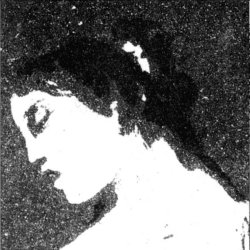
|
AQUATINTE |
|---|---|---|
|
Francisco Goya, detail from Because She Was Susceptible, plate 32 of Los Caprichos, 1798 National Gallery of Canada. |
Francisco Goya, détail de Pour avoir été sensible, planche 32 des Caprices, 1798 Musée des beaux-arts du Canada |
| The medium of aquatint is related to etching, but concerned with areas of tone rather than line. The plate is dusted with powdered asphalt (or resin); the coarseness of the grain is determined by the effects desired. The plate is then heated so that the asphalt particles adhere to the copper. The melted asphalt protects the copper when the plate is immersed in the acid bath; only the copper exposed between the asphalt deposits is bitten. The longer the biting, the darker the tonal areas will print. Areas not to be etched are protected ("stopped out") with an asphalt varnish. | Apparentée à l'eau-forte, l'aquatinte concerne davantage la tonalité que la qualité du trait. La planche de zinc ou de cuivre est recouverte d'une couche de colophane (ou résine) pulvérisée, la grosseur du grain étant déterminée par les effets que l'artiste recherche. La planche est ensuite chauffée pour que la résine se fixe au métal et le protège avant que la planche ne soit plongée dans la cuvette d'acide; seul est alors mordu le métal mis à nu entre les grains de résine. Plus la morsure est longue, plus les tons sont foncés à l'impression. Les parties qui doivent rester blanches sont épargnées au moyen d'un vernis de retouche. |
| LIFT-GROUND ETCHING (SUGAR-LIFT AQUATINT) | GRAVURE DITE « AU SUCRE » |
|---|---|
| With this process, the artist can make the design with positive strokes of the brush, in contrast to the negative procedure of regular aquatint, where a line or area is defined by coating its boundaries with stopping-out varnish. The artist makes the design on a plate with a brush and viscous liquid (often saturated sugar solution or corn syrup). When the drawing is almost dry, a coating of regular etching ground is laid over the whole plate. When this is set, the plate is put in a bath of warm water. This causes the sugar to swell and lift the varnish off the plate, leaving the design in bare metal while the rest of the plate remains covered by the varnish. An aquatint ground is laid on the exposed parts and the plate is bitten in the usual way. | Ce procédé, apparenté à l'aquatinte, diffère cependant de l'aquatinte normale où le trait est délimité par une couche de vernis protecteur ; ici, le pinceau de l'artiste retrouve son rôle premier. Pour tracer le motif sur la planche, le graveur trempe un pinceau dans un liquide visqueux (généralement une solution saturée de sucre ou du sirop de maïs). Quand le dessin est presque sec, l'artiste recouvre toute la surface de la planche d'une couche de vernis pour eau-forte. Lorsque le vernis est sec, il plonge la planche dans un bain d'eau chaude qui fait gonfler le sucre et soulève le vernis, laissant à nu le motif, tandis que le reste de la planche conserve son enduit. Il procède ensuite à une aquatinte sur les parties mises à nu et procède à la morsure. |
RELIEF TECHNIQUE |
PROCÉDÉS EN RELIEF |
| The image is printed from the portion of a block of rigid material that remains above areas which are cut out, or from materials added to a flat surface. Relief prints (other than woodcut and linocut) utilize cut pieces of cardboard or paper pasted on the block in a low-relief image, plastic glue hardened into shapes, cast objects, and other forms of relief. Printing is done either by rubbing the back side of a piece of paper placed on the inked surface of the block, or by running both paper and block through a press. | L'impression se fait non pas à partir des creux, mais des parties laissées en saillie sur un bloc constitué d'un matériau rigide. On peut aussi utiliser des couches ajoutées sur la surface, car les gravures en relief, autres que la gravure sur bois ou la linogravure, créent des motifs légèrement saillants avec des morceaux de carton ou de papier collés, de la colle plastique travaillée et durcie, des moulages et autres formes en saillie. L'impression se fait soit en frottant le verso du papier déposé sur la surface encrée, soit en passant le papier et le bloc sous une presse. |
| WOODCUT |
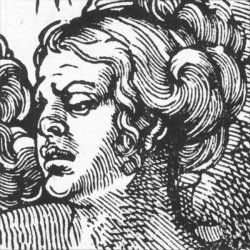
|
GRAVURES SUR BOIS DE FIL |
|---|---|---|
|
Hans Baldung (called Grien), detail from Adam and Eve, 1519 National Gallery of Canada. |
Hans Baldung (dit Grien), détail de Adam et Ève, 1519 Musée des beaux-arts du Canada |
| The artist draws a design directly on a flat block of wood (usually cut on the side grain). Using a gouge or sharp knife, the cutter (sometimes but not necessarily the artist) then cuts away everything but the lines and areas of the image. The design which is to be inked and printed thus stands in relief. A chiaroscuro woodcut is a colour woodcut with a different block for each colour, suggesting the effect of a tonal drawing. | L'artiste dessine son motif directement sur un bloc de bois plat débité le plus souvent dans le sens des fibres. À l'aide d'une gouge ou d'un canif bien aiguisé, le graveur (ou l'artiste lui-même) dégage le bois autour des traits de son dessin qui, ainsi mis en relief, peut ensuite être encré et imprimé. Il existe aussi une gravure sur bois clair-obscur qui utilise un bloc pour chaque couleur, suggérant ainsi des variations de tonalités. |
| LINOCUT | LINOGRAVURE |
|---|---|
| A relief print made from a block of linoleum cut in the same manner as a woodcut. The printed surface has less texture than in a woodcut because of the homogeneous nature of linoleum. | Le graveur utilise un bloc de linoléum qu'il creuse selon les techniques de la gravure sur bois. Parce que le linoléum est un matériau plus homogène que le bois, la surface imprimée a moins de grain que dans la gravure sur bois. |
| WOOD ENGRAVING |
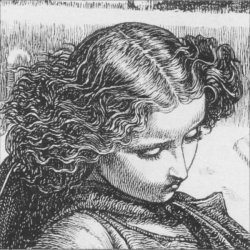
|
GRAVURE SUR BOIS DE BOUT |
|---|---|---|
|
Dalziel Brothers (after Frederick Sandys), detail from The Litttle Mourner, 1862 National Gallery of Canada. |
Les frères Dalziel (d'après Frederick Sandys), détail de la petite fille en deuil, 1862 Musée des beaux-arts du Canada |
| A relief print made from a plank of wood cut on the end grain and hard enough to permit greater fineness and complexity of execution with a burin than found in a woodcut. In a wood engraving, it is often the drawing on the block, rather than the surrounding areas of wood, which is cut away and scooped out. When the block is inked and printed, its surface, rather than that of the engraved design, touches the paper and transfers ink to the sheet, producing white lines on a black background. | L'artiste grave son dessin sur une pièce de bois coupée à contresens des fibres et donc assez dure. Cette technique permet, mieux que la gravure sur bois de fil, d'exprimer les nuances et les finesses du motif. Le plus souvent, le graveur creuse son motif en épargnant tout le reste de la surface. Ce n'est donc pas le motif qui est encré et imprimé sur la feuille, mais la surface de bois épargnée. On obtient ainsi des lignes blanches sur fond noir. |
| RELIEF ETCHING | EAU-FORTE EN RELIEF |
|---|---|
| A name sometimes given to a print from a metal plate produced by etching away all but the design. The artist executes a design on the plate with an acid-resisting varnish. The plate is then put in an acid bath until enough of the exposed parts are eaten away to bring out the design in relief. The plate is then printed like a woodcut. | On donne parfois ce nom à une impression réalisée à partir d'une planche de métal où toute la surface, sauf le motif, a été mordue. L'artiste ayant d'abord peint son motif sur une planche de métal en utilisant d'un vernis protecteur, celle-ci est ensuite plongée dans un bain d'acide jusqu'à ce que les parties non peintes soient suffisamment creusées pour faire ressortir le motif en relief. On procède ensuite à l'encrage comme dans le cas de la gravure sur bois. |
PLANOGRAPHIC TECHNIQUE |
PROCÉDÉS À PLAT |
| The image to be printed is created upon the surface of a stone or plate which is altered chemically rather than dimensionally. The stone or plate is inked, covered with paper, and printed on a flatbed press. Plates made in this manner may also be printed on an offset press. | L'artiste dessine sur une pierre ou une planche qu'il traite ensuite selon diverses techniques, privilégiant toutefois les méthodes chimiques aux procédés de taille directe en relief ou en creux. Le support sera ensuite encré et recouvert d'une feuille ; l'impression se fait à plat sur une presse mécanique. Des plaques ainsi préparées peuvent aussi être imprimées en offset. |
| LITHOGRAPHY |
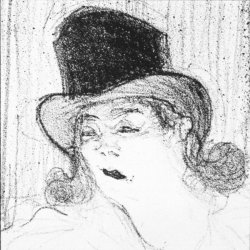
|
LITHOGRAPHIE |
|---|---|---|
|
Henri de Toulouse-Lautrec, detail from Cecy Loftus, 1894 National Gallery of Canada. |
Henri de Toulouse-Lautrec, détail de Cecy Loftus, 1894 Musée des beaux-arts du Canada |
|
Lithography involves the printing of an image from a flat surface. The technique, which was
invented in the late eighteenth century, relies on the principle that oil and water repel each
other. Traditionally employing a limestone slab which has been roughened or smoothed according
to the effects desired, the lithographer draws directly on the surface with a greasy crayon or
with a brush and a liquid ink called tusche. Drawings for lithographs can also be made on
specially treated zinc or aluminum plates (hence zincography and algraphy).
After the drawing is completed, the stone is washed with a solution of nitric acid and gum arabic. This process, called "etching" the stone, produces a chemical separation between printing (image) and non-printing (non-image) areas. The grease from the crayon or tusche is liberated into the pores of the stone and the non-printing areas become desensitized, so that they do not attract grease. When the stone is to be printed, it is first washed with water. The non-printing areas attract and retain a film of water; the greasy areas repel the water. Printing ink is then applied to the stone with a roller. The greasy areas, which represent the printing image, attract and hold the ink. Because of the mutually repellent nature of grease and water, the ink does not adhere to those areas covered with a film of water. After inking, the stone, placed upward on the bed of the press, is covered with a sheet of dampened paper and run through the press. The printed image reverses the composition as drawn on the stone. In colour lithography a different stone is prepared for each colour and printed successively in register. Since they are printed from a flat surface, the lines in a lithograph are neither raised, as in intaglio processes, nor pressed into the paper, as in relief processes. |
Inventée à la fin du XVIIIe siècle, la lithographie repose sur la technique de répulsion de l'eau par les corps gras. Le
dessin à reproduire est d'abord tracé sur une surface plane, en général une pierre calcaire, rendue rugueuse ou
polie selon l'effet recherché. L'artiste dessine directement sur la pierre avec un crayon gras ou un pinceau trempé
dans une encre grasse, l'encre lithographique. On peut aussi exécuter les dessins à lithographier sur des planches,
spécialement traitées, de zinc (zincographie) ou d'aluminium (algraphie).
Une fois le dessin terminé, on lave la pierre avec un mélange d'acide nitrique et de gomme arabique. Ce mélange a une action chimique différente sur les régions à imprimer (dessinées) et les autres (non dessinées). Les traces grasses laissées par le crayon ou l'encre lithographiques, pénètrent dans les pores de la pierre ; les autres régions repoussent les corps gras. Avant l'impression, la pierre est mouillée et les parties réservées, non grasses, se couvrent d'une pellicule d'eau. L'encre est ensuite appliquée sur la pierre au moyen d'un rouleau. Les parties dessinées, grasses, attirent et retiennent l'encre ; à cause de l'incompatibilité réciproque du gras et de l'eau, l'encre n'adhère pas aux surfaces mouillées. Après encrage, la pierre est posée sur le chariot de la presse et recouverte d'une feuille de papier humectée; et l'on procède au tirage. L'image obtenue est à l'envers par rapport à la composition tracée sur la pierre. À noter que la lithographie en couleurs exige autant de pierres que de couleurs et que ces opérations exigent un repérage parfait. Imprimés à partir d'une surface plane, les traits d'une lithographie ne résultent ni d'un relief ni d'un creux comme dans les autres procédés. |
| TRANSFER LITHOGRAPHY | LITHOGRAPHIE DE REPORT |
|---|---|
| A drawing made with lithographic crayon on a specially prepared "transfer paper" can be transferred to the lithographic stone by laying the drawing face down on the stone and passing it through the press. Once the image has been transferred, one proceeds as with a regular lithograph. Naturally, the texture of the transfer paper shows in transfer lithographs. Since the image is reversed when transferred to the stone, the printed image is in the same direction as the artist's drawing. | Un dessin exécuté au crayon lithographique, sur un papier à report spécialement préparé ou papier autographique, peut être transféré sur une pierre lithographique. On couche le dessin sur la pierre, puis on passe celle-ci sous la presse. Une fois l'image reportée, on procède comme pour une lithographie ordinaire. La texture du papier de report demeure toutefois apparente dans les lithographies de ce genre. L'impression lithographique a l'avantage de remettre à l'endroit l'image que le report avait inversée. |
| OFFSET LITHOGRAPHY | LITHOGRAPHIE OFFSET |
| An application of lithographic techniques to commercial and quantity production. An image can be photographed onto a stone, zinc, paper, or aluminum plate, by the interpolation of a screen. The resulting production can be printed in the usual way by hand inking and hand printing. The printing process can, however, be expedited by the use of an offset printing machine. This is a rotary press, and consequently only zinc, aluminum, or paper plates capable of being bent round a cylinder can be used. The offset principle involves a double printing. The inked image from the plate is printed on a rubber blanket or roller which in turn prints it on a sheet or roll of paper. The ink used is rather thin to facilitate quick inking and easy transfer. Because of the lightness of the printing, the offset press is often used by artists in the execution of large colour lithographs, particularly when many colour plates are involved. Another attraction of this press is that it produces a printed image which does not reverse the composition as executed on the plate. | Ce procédé de reproduction en série utilise les techniques lithographiques dans un but commercial. La photographie d'une image sera transférée sur une pierre ou une planche de zinc ou d'aluminium, par l'intermédiaire d'un écran. L'image ainsi obtenue est imprimée de la façon habituelle par encrage et impression à la main. L'impression elle-même peut cependant être accélérée en ayant recours à une machine à imprimer en offset - la rotative - mais seules les feuilles de zinc, d'aluminium ou de papier sont assez souples pour être tendues sur son cylindre. De plus, le procédé offset suppose une double impression. La planche encrée est imprimée sur un rouleau en caoutchouc - le blanchet - qui reporte l'image sur une feuille ou un rouleau de papier. L'encre, assez liquide, permet un encrage rapide et un report facile. La maniabilité du procédé est telle que les artistes y recourent pour les lithographies en couleurs de grand format, celles surtout qui comportent plusieurs planches. Autre caractéristique de cette technique, elle n'inverse pas l'image tracée sur la planche. |
STENCIL TECHNIQUE |
PROCÉDÉS AU POCHOIR
|
| The image is created from open space in a cut or shaped form which allows ink or paint to pass through when applied with a brush (for pochoir), or squeegee or airbrush (for silkscreen). | Le motif est découpé dans une plaque ou collé sur un écran permettant le passage de l'encre ou de la peinture que l'artiste applique au moyen d'une brosse (pochoir), d'une raclette ou d'un aérographe (sérigraphie). |
| POCHOIR | POCHOIR |
| Stencils cut in paper or very thin sheets of metal, invented in China, were used to colour popular prints in quantity in Europe from the fifteenth century on. From the old stencil process was developed the silkscreen printing method. In France around the 1920s, however, an expert craftsman, J. Saudé, used the pochoir process as a reproductive medium for illustrating books. | Dès le XVe siècle, des artisans européens taillaient des motifs dans des plaques de papier ou de très minces feuilles de métal qu'ils employaient pour ajouter de la couleur aux gravures populaires produites en série. De cet ancien procédé inventé en Chine est née la sérigraphie. Vers les années 1920, cependant, un Français fort adroit, Jean Saudé, emploie le pochoir pour illustrer des livres. |
| SILK SCREEN (SERIGRAPHY) | SÉRIGRAPHIE |
|
The artist stretches a piece of fine silk over a wooden frame and then glues a design in the
form of a stencil to the fabric. Paint (or silkscreen ink) is then forced through the screen
onto a sheet of paper below by means of a squeegee. The uncovered areas of fabric will, of
course, allow the paint to pass through, while the areas covered by the cut stencil will not.
Most current stencil methods are more sophisticated. These include the sealing of the areas of silk which are not to be printed with an adhesive rather than a cut-paper stencil; a method in which the design is drawn on the screen with lithographic tusche, after which the screen is covered with a thin coating of glue or size and finally washed with benzine, which dissolves the areas of tusche so the paint can pass through the design, but does not dissolve the glue; the use of light metal rather than fabric screens; and the use of photosensitized film as the stencil so that photographic images can be reproduced. |
L'artiste tend un écran de soie fine sur un cadre en bois. Sur cette trame,
il colle les motifs prédécoupés (le procédé se rapproche
donc du pochoir). Au moyen d'une raclette, il applique, en appuyant fortement, de la peinture
ou de l'encre sérigraphique sur l'écran qu'il a pris soin de placer au-dessus
d'une feuille de papier. Seules les surfaces non recouvertes laissent passer la peinture.
Les techniques courantes de la sérigraphie sont toutefois, pour la plupart, plus élaborées. On isolera par exemple les surfaces de la soie qui doivent être réservées avec un enduit imperméable plutôt qu'avec une plaque en papier découpé. L'artiste peut aussi, après avoir dessiné son motif sur l'écran avec de l'encre lithographique, recouvrir celui-ci d'une mince couche de colle ou de gomme et le laver à la térébenthine afin de dissoudre les surfaces encrées pour que la peinture traverse le motif ; la colle restera cependant intacte. Enfin, il pourra aussi remplacer le tissu par un métal léger ou par une pellicule photosensible qui permettra d'opérer un report photographique. |
MISCELLANEOUS |
AUTRE PROCÉDÉ |
| MONOTYPE | MONOTYPE |
| A single printing of an image incapable of being identically reprinted. The most common technique is to paint the image on glass or metal and print it before the ink or paint dries. It sometimes happens that some of the brushed pigment still remains on the plate after the first printing, and that a second impression of a monotype can be run off the press. This replica is but a pale reflection of the original conception. | Cette technique ne permet d'obtenir qu'une seule épreuve à partir de l'image originale. L'artiste peint d'ordinaire celle-ci sur une planche de verre ou de métal, puis l'imprime avant que l'encre ou la peinture ne sèche. Si, après le premier tirage, une partie du pigment demeure sur la planche, il pourra lever une deuxième épreuve qui ne sera cependant qu'un pâle reflet de l'original. |
SUGGESTED READING |
LECTURES RECOMMANDÉES |
|
Felix Brunner, A Handbook of Graphic Reproduction Processes, Switzerland: Verlag, 4th edition, 1972. Bamber Gascoigne, How to Identify Prints, London: Thames and Hudson, 1986. Antony Griffiths, Prints and Printmaking: An Introduction to the History and Techniques, London: British Museum Publications, 1980. Jules Heller, Printmaking Today, 2nd edition, New York: Holt, Rinehart and Winston, 1972. William Ivins, Jr., How Prints Look, Boston: Beacon Press, 1968. Carl Zigrosser and Christa M. Gaehde, A Guide to the Collecting and Care of Original Prints, New York: Crown Publishers, 1975. |
Felix Brunner, Manuel de la gravure, 4e édition,
Suisse, Éditions Verlag, 1972. Bamber Gascoigne, How to Identify Prints, Londres, Thames and Hudson, 1986. Antony Griffiths, Prints and Printmaking: An Introduction to the History and Techniques, Londres, British Museum Publications, 1980. Jules Heller, Printmaking Today, 2e édition, New York, Holt, Rinehart and Winston, 1972. William Ivins, Jr., How Prints Iook, Boston, Beacon Press, 1968. Nicole Malenfant, L'estampe, Québec, Éditeur officiel du Québec, Collection Formart, 1979. Carl Zigrosser et Christa M. Gaehde, A Guide to the Collecting and Care of Original Prints, New York, Crown Publishers, 1975. Dans la collection « Initiation aux métiers d'arts du Québec », Montréal, Formart: Janine Leroux-Guillaume, La gravure sur bois de bout, 1972; Robert Savoie, L'eau-forte en couleurs, 1972; Roland Giguère, La sérigraphie à la colle, 1972; Albert Dumouchel, La lithographie, 1972; Robert Wolfe, La linogravure, 1974; René Derouin, La sérigraphie (film découpé), 1972; Pierre Ayot, La sérigraphie photomécanique, 1974; Monique Charbonneau, La gravure sur bois de fil, 1972. |
|
Illustrations are details of works in the collection of the National Gallery of Canada.
© National Gallery of Canada, Ottawa, 1991 |
Les illustrations sont des détails d'oeuvres tirées de la collection du Musée des beaux-arts du Canada.
© Musée des beaux-arts du Canada, Ottawa, 1991.
Revu et corrigé par Jean-Claude Bergeron, 1998 |
| |
|
|